As an introduction, King Min Bin is also referred to as King Mong Bar Gre, the donor of Shit-taung. King Tikkha, also spelled Dikkha, was king for 3 years after his father died. He donated Koe-Thaung during his short reign. The temple was built in 1553 and was built in six months.
Koe-thaung Pagoda – Architecture and Excavation
The excavation of Koe-thaung began on September 9, 1996. Before that all that it was was a hill of bushes. This is a massive structure. According to Myar Aung, the western basement measures 250 feet long and north to south, it is 230 feet. From the southeast to the northeast it’s 77 feet at the base. The renovators added corrugated iron lintels from the baseline to the arches of the open doorways leading deeper into the structure. Dr. Gutman states the size as about seventy-seven meters on each side, which is about 253 feet.
Walking through the catacombs of passages, I could not have told you that this monument was square in any way. Maybe we were completely mesmerized by all of the buddha images and ogre carvings on the deep brick walls faced with sandstone. I would love to go back someday and intentionally circumambulate the entire pagoda.
108 small pagodas originally decorated the five receding terraces. Entrance stairs lead up to two ambulatory passages. Another set of brick steps takes one to the large stone Buddha seated in the pose of calling the earth to witness, on a large stone base. In fact, this is the same pose that all of the buddha images in Koe-Thaung Pagoda sit. Stepped niches of thousands of small carved buddhas adorn the walls throughout the pagoda.
Koe-thaung Buddha images
Koe-thaung was built in only six months, according to the chronicles. This could explain the flatter and more stylized images than previously as well as the differences in workmanship and artistry. This image style clearly belongs to the Mrauk U Kingdom Middle Phase. First they are massively constructed with broad shoulders. Prominent nipples extrude from a bulging chest. Their large heads are bent slightly forward. The faces are abstract, as in condensed, with joined eyebrows, heavy half-closed eyelids and full lips. Sometimes the long earlobes reach to the shoulders and the hair finishes in a round or square topknot. Even the dress is different. Buddha’s thin robe passes over the right shoulder leaving the left shoulder bare.
The central image of Koe-thaung is the most superior in quality to all of the rest. The animals and guardian figures seen in Dr. Gutman’s book are no longer there. It is now covered by a wood and fiberglass roofed shed. What is also no longer seen is the red lacquer and gilding originally applied. Because the red lacquer intensifies the gold laid on top of it, this is a technique in use in Myanmar today.
Ogres or Door Guardians of Koe-thaung
Last but not least, in conclusion, call it an ogre or a door guardian, these life-size carved images are there to protect and guard the doors. Myar Aung describes them as ogres in stone sculpture. Most of them, it appears, carry a knife or a sword. They may carry shields blowing conch shells as if in royal or religious ceremony. And then there are the short and squat ones with large heads and knees spread outwards as in a squatting position. These are the demons hand picked by the Buddha to drive evil away from the shrine.
References:
Gutman, Pamela – 2001, Burma’s Lost Kingdoms: Splendours of Arakan, Orchid Press, Bangkok
Myar Aung – 2007, Famous Monuments of Mrauk U (Useful Reference for Tourists and Travelers)
